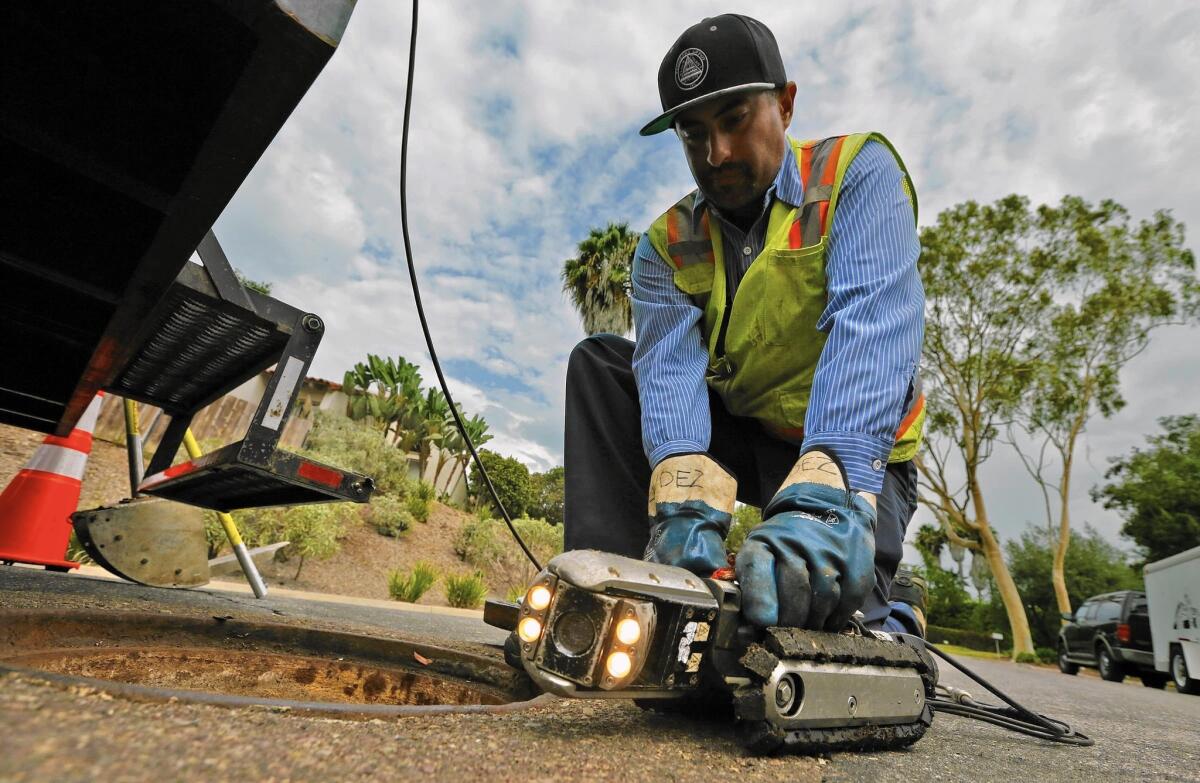Unintended consequences of conserving water: leaky pipes, less revenue, bad odors

Hugo Gonzalez, a Leucadia Wastewater District technician, prepares a camera to search for roots in a Carlsbad, Calif., sewer line. Without normal levels of outdoor irrigation, tree roots in search of water have invaded sewer pipes and grown there over time.
Under orders to slash water use amid a historic drought, cities and towns across the state saved about 75 billion gallons in July, eclipsing Gov. Jerry Brown’s once-daunting order for a 25% reduction.
But, in a paradox of conservation, water agencies say the unprecedented savings — 31% in July over July 2013 — are causing or compounding a slew of problems.
Sanitation districts are yanking tree roots out of manholes and stepping up maintenance on their pipes to prevent corrosion and the spread of odors. And when people use less potable water, officials say, there’s less wastewater available to recycle.
See the most-read stories this hour >>
Water suppliers, meanwhile, say the dramatic decrease in consumption has created multimillion-dollar revenue shortfalls.
Experts and industry leaders say this represents a shift into a new stage of the four-year drought.
“It’s unintended consequences,” said George Tchobanoglous, a professor of civil and environmental engineering at UC Davis. “We never thought [conservation] was a bad thing. Every citizen thinks he or she is saving mankind, and I’m sympathetic, but it just so happens that our basic infrastructure was not designed with that in mind.”
Sanitation districts have worried about sewer spills for years, but officials say they have had to become especially vigilant in recent months as water use has plummeted.
Shorter showers, more efficient toilets and other reductions in indoor water usage have meant less wastewater flowing through sewer pipes, sanitation officials say. With less flow to flush the solids down the system, those solids are collecting and can eventually damage pipes.
“The costs that we’re going to face due to corroding pipes is going to be astronomical,” Tchobanoglous said. “It’ll dwarf everything else.”
NEWSLETTER: Get the day’s top headlines from Times Editor Davan Maharaj >>
In Sacramento, the sewer system is relatively flat, meaning that gravity cannot help push solids through it. Operators are reporting increased debris and more grease in pipelines, said Christoph Dobson, director of policy and planning at the Sacramento Regional County Sanitation District.
The collection of those solids heightens the possibility of a stoppage in small pipes and increases the amount of maintenance that sanitation districts must perform, Dobson said.
“We do know that we’re seeing lower flows, and we do attribute the problems … to those lower flows,” he said.
In San Francisco, officials also say foul odors have become noticeable in low-lying and flat areas of the city where gravity cannot help push solids through the system.
Sanitation officials in Orange County say that although their system is generally holding up well, they have had to flush and clean the pipes more often. Since the wastewater ends up with a higher concentration of solids, the pumps that lift and move the water could get worn down faster, officials said.
“Did we know the drought was coming and it would cause these things? Not necessarily,” said Rob Thompson, director of engineering at the Orange County Sanitation District. “Nobody likes to talk about sewage. Sewage isn’t sexy.”
Los Angeles has not experienced many of the problems plaguing its neighbors because its system is designed to move wastewater by gravity, and officials say that with 4 million people using water, there’s always enough flow.
Water and Power is The Times’ guide to the drought. Sign up to get the free newsletter >>
Experts said conservation has certainly brought challenges, but pointed out that in Australia — where water use plunged during a drought that lasted more than a decade — there’s no evidence of wastewater treatment problems.
“My view is that any such consequences can be managed if and when they arise, but this should not be an excuse to not implement efficiency measures,” said Lester Snow, a former head of the Department of Water Resources who now directs the California Water Foundation.
The reduced use of drinkable water also means there is less available for recycling — at a time when cities have been placing a greater emphasis on that form of water conservation, experts say.
Orange County is home to the largest potable reuse facility in the world. Because of a recent facility expansion and the high levels of conservation, the Groundwater Replenishment System now requires wastewater to be diverted from Huntington Beach to Fountain Valley in order to keep the facility at 95% capacity.
“We’re hoping that water demands will remain fairly consistent inside the house,” said Mike Markus, general manager of the Orange County Water District.
Lower water demands “potentially could be a problem for us because we built a facility of a certain size and we want to make those assets work for us,” Marcus added. “We don’t want to have stranded assets.”
At the Leucadia Wastewater District in northern San Diego County, officials have run into a different problem.
Without normal levels of outdoor irrigation, tree roots desperately in search of water have invaded sewer pipes and grown there over time.
Last December, when workers investigated a sewer spill, they found a 4- to 6-inch-wide tree root inside a pipe. Just 16 months earlier, an inspection found the sewer line “clean and clear,” said Paul Bushee, general manager of the Leucadia Wastewater District.
“We’re seeing more and more of that,” he said. “It was a learning experience for us. We didn’t think a root could go from nothing to this larger-diameter root in a year and four months.”
But the consequences of conservation have also been felt outside sanitation districts. Potable water providers say conservation is stripping them of crucial revenue.
For example, the Yorba Linda Water District is under state orders to slash its water consumption 36% over the next several months. A cut that size is projected to reduce revenue about $9 million over the course of the current fiscal year, district spokesman Damon Micalizzi said.
The water district had been planning to ask for a gradual rate increase over five years, but the state’s conservation mandate forced the district to speed up that process and ask for more money sooner, Micalizzi said.
Under the latest rate proposal, the basic service charge assigned to most single-family residential customers would jump to about $41 on Oct. 1 from $16.77, Micalizzi said.
“We’re feeling the pain right now,” he said. “To have this dramatic jump and the backlash that obviously comes with it is very, very daunting.”
The Santa Margarita Water District also passed a water rate increase in March that will help offset $6.8 million in lost revenue this fiscal year. Goleta Water District officials said they implemented a “drought surcharge” in July to help recover $10 million in projected revenue loss.
“It’s a fact that the amount of revenue [water districts are] collecting is going down,” said Heather Cooley, water program director of the Pacific Institute, a nonprofit that conducts research on natural resources.
Conservation, she continued, “puts water districts in a pinch in the short term, but in the long term it’s a benefit for all of us.”
Twitter: @ByMattStevens
ALSO:
L.A. trash agency ordered to clear backlog of illegal dumping complaints
Murder trial sends message to doctors: ‘Don’t get reckless,’ medical expert says
Police worry about their own safety after killings: ‘It’s a different world’
More to Read
Sign up for Essential California
The most important California stories and recommendations in your inbox every morning.
You may occasionally receive promotional content from the Los Angeles Times.











